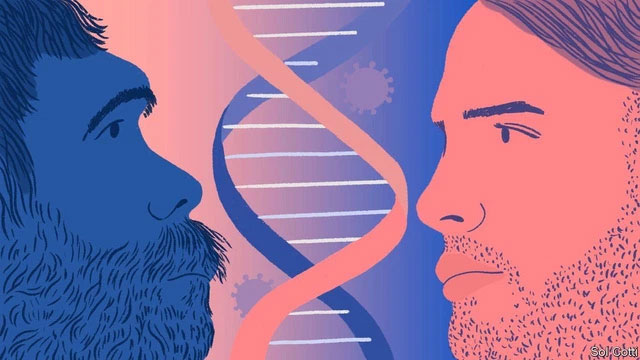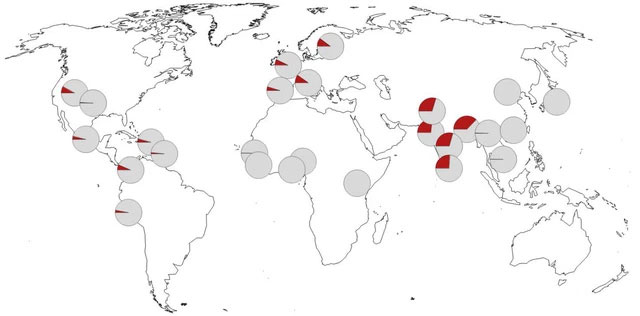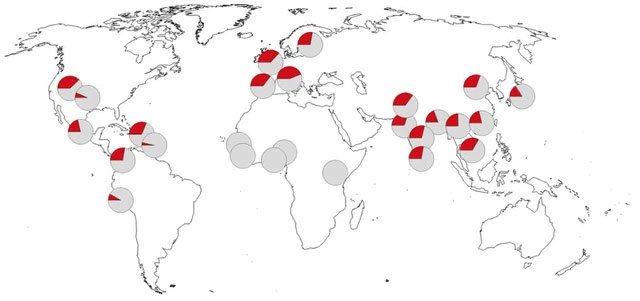One of our Homo Sapiens relatives, the Neanderthals, went extinct about 40,000 years ago. However, their genes have not completely disappeared from Earth.
Genetic evidence shows that before their extinction, Neanderthals lived alongside modern humans. A portion of Homo Sapiens interbred with Neanderthals, resulting in hybrid offspring.
As a result, nearly half of the Neanderthal genome is still passed down to this day. These DNA segments are scattered throughout each of us (except for individuals of pure African descent, whose ancestors never interacted with Neanderthals).

A portion of Homo Sapiens interbred with Neanderthals, resulting in hybrid offspring.
However, Neanderthal DNA is not just present in our bodies; it also influences many traits, from fat metabolism efficiency to hair thickness. Numerous studies have shown that Neanderthal DNA is related to the immune system of Homo Sapiens and affects the risk of developing various diseases, including lupus, Crohn’s disease, and diabetes.
Recent scientific papers indicate that Covid-19 is also on this list. Specifically, there are two DNA segments inherited from Neanderthal ancestors: one beneficial segment that can help resist Covid-19, and one detrimental segment that increases the risk of severe illness and hospitalization.
Fortunately, a large proportion of the Vietnamese population is identified as having the beneficial DNA segment from Neanderthal ancestors. This gene helped us withstand the SARS epidemic in 2003 and continues to reduce the risk of severe Covid-19 symptoms by 22% for those who carry it.
Detrimental Haplotype on Chromosome 3
This discovery was made by researchers Hugo Zeberg and Svante Pääbo at the Max Planck Institute for Evolutionary Anthropology in Leipzig, a leading institution in Neanderthal DNA research.
In a paper published in September in the journal Nature, Zeberg and Pääbo described a Neanderthal DNA sequence known as “haplotype,” which may increase the risk of severe Covid-19 compared to the general population.
Specifically, one copy of the haplotype (found on chromosome 3 among the 46 chromosomes in humans) doubles the risk of Covid-19 patients needing intensive care (ICU). Those unfortunate enough to possess two copies — one from each parent — face even higher risks.
Notably, this study may explain why, in the early days of the pandemic, Covid-19 affected Western countries more than Eastern ones. This is due to the uneven genetic distribution of the haplotype.
The Neanderthal gene sequences that increase the risk of severe Covid-19 are most common among South Asians, with 63% of the Bangladeshi population carrying at least one copy of the detrimental haplotype. In Europeans, this rate is about 16%. Detrimental haplotypes are rare in East Asia and, as predicted, almost completely absent in Africa.
The exact impact of this detrimental haplotype on our bodies is still unclear to scientists. They have recently discovered a gene within it that encodes a protein interacting with the receptors of the cells that the SARS-CoV-2 virus uses to invade and commandeer our organelles for reproduction.
Haplotypes are also thought to be involved in the production of signaling proteins, known as cytokines, which help regulate the immune system. An overly strong immune response is one of the mechanisms that make Covid-19 a deadly disease.
On the other hand, some cytokines protect against cholera. Researchers speculate that this could explain why the haplotype on chromosome 3 is prevalent in Bangladesh and India, where cholera has long been a problem.
Finally, there is additional evidence suggesting that even though evolution has promoted the emergence of the detrimental haplotype in some populations, evolution is also working to eliminate it from others.
South Asians are increasingly carrying these haplotypes, while East Asians are increasingly shedding them, Dr. Pääbo noted. “The difference in frequency [of this haplotype] between South Asians and East Asians is so significant that we cannot help but suspect that natural selection in the past has played a role in this process,” he said.

Distribution of the detrimental haplotype on chromosome 3, making Covid-19 patients more likely to experience severe symptoms.
Beneficial Haplotype on Chromosome 12
A second study published this week in the Proceedings of the National Academy of Sciences relates to another haplotype from Neanderthals. This haplotype, found on chromosome 12, protects carriers from severe Covid-19 infections.
Those with the beneficial haplotype on chromosome 12 can reduce their risk of hospitalization due to Covid-19 by 22%. The good news is that most populations worldwide, except for the sub-Saharan region of Africa, possess this haplotype.
Among Europeans and Asians, 2 to 4 out of every 10 individuals carry one copy of it. In Vietnam, more than a quarter of the population possesses this Covid-19 protective haplotype in their genes.
In this second study, scientists learned more about the workings of the beneficial haplotype compared to the detrimental one. This is because they had previously noted it before discovering that this haplotype originated from Neanderthals.
The haplotype on chromosome 12 hinders the spread of viral RNA. Previous studies have shown that this haplotype protected its carriers from hepatitis C virus, West Nile virus, and the SARS virus in 2003. Covid-19, caused by the SARS-CoV-2 virus, is also an RNA virus, and thus it is also blocked by the haplotype on chromosome 12.
In 2005, a group of scientists from Bach Mai Hospital and the Central Institute for Hygiene and Epidemiology analyzed the impact of the haplotype on patients infected with the SARS virus and found that it seemed to have antiviral properties.

Distribution of the beneficial haplotype on chromosome 12 protecting against Covid-19.
Hugo Zeberg and Svante Pääbo hope that their work can now help clarify why some countries and certain population groups within countries seem to be more affected by Covid-19 than others. For instance, they point out that the Covid-19 wave has impacted populations at nearly double the rate of the general population.
However, using DNA alone to predict disease effects is also very challenging. This is because there are countless other factors that can influence an individual’s risk for Covid-19, including age, obesity, and gender.
Comparing countries is also very complex due to unidentifiable differences and difficulties in conducting accurate counts, especially in poorer nations. For example, despite the prevalence of the detrimental haplotype, the official Covid-19 death rate in Bangladesh is only 5.1 per 100,000, significantly lower than in countries where this haplotype appears much less frequently.
Nevertheless, this does not mean that examining DNA fragments like those from Neanderthals is pointless. They remain useful in many cases, especially if Covid-19 becomes endemic in the future; affordable gene sequencing could help doctors assess which patients are most likely to be adversely affected by it.
Understanding the mechanisms by which genes determine resistance or susceptibility to Covid-19 could also aid in the search for and selection of treatments. History shows that SARS-CoV-2 will not be the last coronavirus strain to infect humans.
If certain populations are indeed more vulnerable to this virus strain, knowing this in advance through their DNA could be invaluable knowledge that helps us better prepare for future pandemics.


















































